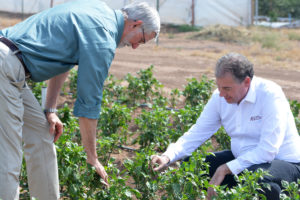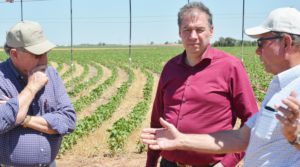Connecting agriculture to human health mission of new Texas A&M vice chancellor
Writer: Kay Ledbetter, 806-677-5608, skledbetter@ag.tamu.edu
AMARILLO – Most people don’t understand the role agriculture plays in their health and daily lives, but Texas A&M University’s new vice chancellor for Agriculture and Life Sciences is ready to change that.

Dr. Patrick Stover, who is also Texas A&M AgriLife Research’s acting director in College Station, visited the Amarillo and Lubbock area to discuss a new path forward in reconnecting people to agriculture.
Stover not only visited with employees of the Texas A&M University System – AgriLife Research, the Texas A&M AgriLife Extension Service, West Texas A&M University, Texas A&M Veterinary Medical Diagnostic Laboratory and Texas A&M Forest Service – but also with commodity and industry leaders.

“Nobody can afford health costs anymore,” Stover said. “Diet-related chronic disease costs the economy $1 trillion a year. That frightens people, because somebody has to pay that bill.”
Stover said the problem is not just the food grown or how it is processed or how consumers make their choices.
“It’s the whole system,” he said. “What we need to understand across the board: if we want better agriculture and an appreciation of agriculture, we have to be able to demonstrate to people how food is produced and how food really promotes their health and well-being.”
Stover said the evidence base that ties food to health requires research, both in terms of producing food that is more healthful and how dietary patterns can lower chronic disease.

“We don’t have the data right now, and the approach we use to collect that data is flawed, because we assume that everybody is the same and we use population averages,” he said. “But, there is no average person. Individuals respond differently to diets, and it is modified by all sorts of factors. We have to understand individuals and where they are in their stage of life.”
Texas is the ideal place to do that research, Stover said. It is heavily invested in food and fiber in its agriculture, plus has areas of population in public health crisis and has a commitment to make changes at the highest levels.

“We have the opportunity to do something really special,” he said.
Stover said Texas A&M is committed to having a strong presence in the High Plains because of its importance to the Texas economy – agriculture contributes $7.2 billion to the state’s economy, and this region plays an important role in that contribution.
He outlined a three-part approach to be used moving forward, including responsive agriculture – listening and reacting to the needs of the producer; precision agriculture – focusing on individual plants and animals; and collecting big data for decision-making.
These are the tools he plans to direct agencies to use to better align agriculture with a health focus to benefit producers, consumers, the environment and the economy.

It is critical that the support for the agricultural and rural culture is not eroded as more urbanization takes place, Stover said, so “we need to better align what the consumers want with what agriculture is providing.”
In the future, researchers will continue to have to worry about drought resistance and higher yields, but also about flavor and nutrient content and other qualities that will gain popularity with the general public and also meet society needs, such as health costs.
“As Texas becomes increasingly urban, we need to be sure people appreciate the value of food in their lives; appreciate food as a national security issue,” Stover said. “We need a way to ensure that all Texans, whether they are urban or rural, have a firm appreciation of the role of agriculture in their life.
“We have to make a better case for more investment in agriculture research, because what we do has a direct impact on quality of life, the economy, and to our health and welfare and national security.”


